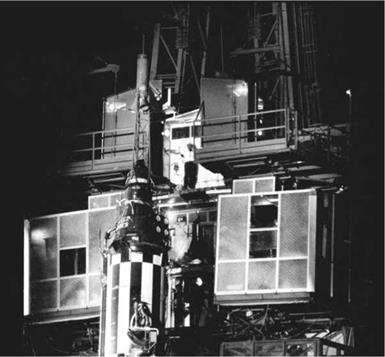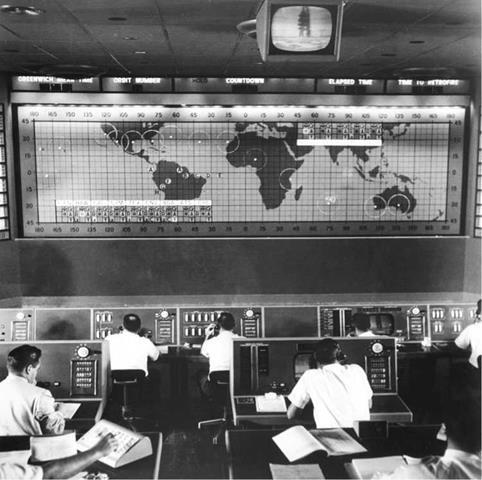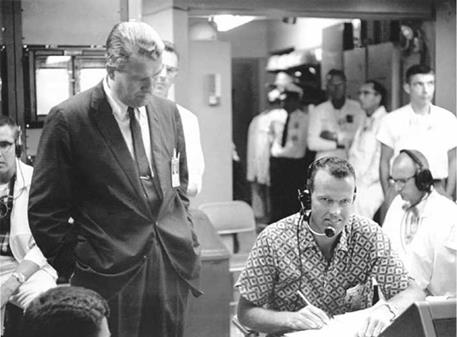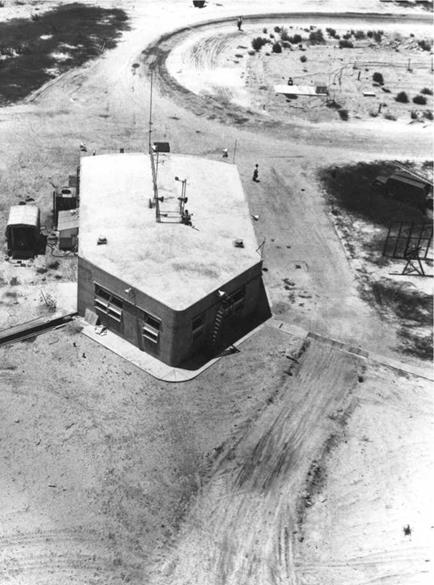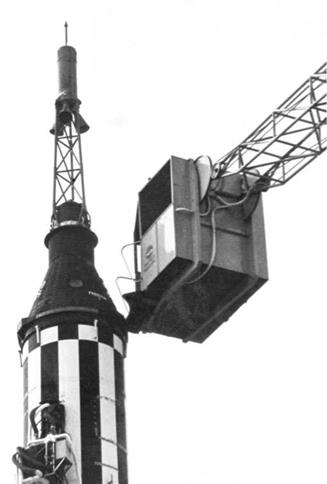DELAY AFTER DELAY
As dawn broke over the New Hampshire hills, the first pale rays of the Sun fell on a crisp new American flag that had been proudly raised earlier that morning by Renza Shepard on the front lawn of their home in East Derry.
|
The launch gantry begins to roll away. (Photo: NASA) |
Aboard the aircraft carrier USS Lake Champlain (CVS-39), the prime recovery ship, the crew stood silently in the dawn light as Rev. Henry Faville Maxwell, their chaplain, intoned a heartfelt prayer for the success of Shepard’s mission over the ship’s loudspeakers.
“Dear Lord who hears us, now that a precious life is about to be flung into the heavens, we are filled with fear; we are afraid of imminent danger. Dear Lord who hears us, we thank Thee for giving us men ready to sacrifice their existence to open up for us the doors of space. May he succeed without losing his life. May success crown his endeavors to explore the paths of knowledge; not only that we may expand into the universe, but that it will be a peaceful universe where we live with each other and with Thee. Amen.” [24]
In the Pad 5 blockhouse, fellow astronaut Gordon Cooper communicated with the capsule until this task transferred to Deke Slayton in the Mercury Control Center. By then, Slayton had been joined by Flight Director Chris Kraft and Operations Director Walt Williams.
As Williams later recalled of that day, “You can say that intuition means nothing, but there are days when you feel things are right and days when you feel things are wrong. On the previous Tuesday, the weather was a problem – but that was only one factor. We were having small problems – no serious ones, but things weren’t going well. That is why I scrubbed quite early.
“On Friday, even though we had problems, I felt that we could handle each one as it came up. I was in the Mercury Control Center – at the back of the room. Before that, I had been roaming around to the pad, the blockhouse, up the gantry, in to see how Al was coming along. Once I put on my ‘Operations Director hat,’ I am in total charge. I don’t mean that in an autocratic way, but someone has to call the shots. In essence, I answer to no one except the President. Once we are under way with the countdown, it is a minute-by-minute decision whether we go or not.” [25]
Once the gantry had rolled on its tracks clear of the Redstone, Shepard began to feel more confident by the minute. “The periscope gave me a view of clouds lit by the morning Sun. Far below, I watched the launch crew finishing last-minute details at the base of the rocket. I glanced at my capsule timer. Only fifteen minutes to go. The view outside dimmed. Cloud cover rolling in. Damn!”
Now the brightness of the Sun was intruding into the cabin through the periscope, so Shepard cranked a couple of filters over the screen to diminish the glare.
The countdown clock stopped during the delay, and everyone began scanning the skies, eager for the clouds to depart. “Everyone hated countdown delays,” Shepard later observed. “They just allowed more time for something to go wrong.” [26]
And something did go wrong. An inverter, a small electrical part in the rocket that changed DC current to AC, developed a fault. It may have been a relatively minor thing, but it had to be fixed. Everything had to be fully operational for the mission to proceed. To everyone’s disappointment, the launch director ordered the gantry rolled back in.
As Shepard observed later, “There was a time during the countdown when there was a problem with the inverter in the Redstone. Gordon Cooper was the voice communicator in the blockhouse. So he called and said, ‘This inverter is not working in the Redstone. They’re going to pull the gantry back in, and we’re going to change inverters. It’s probably going to take about an hour, an hour-and-a-half.’ And I said, ‘Well, if that’s the case then I would like to get out and relieve myself.’
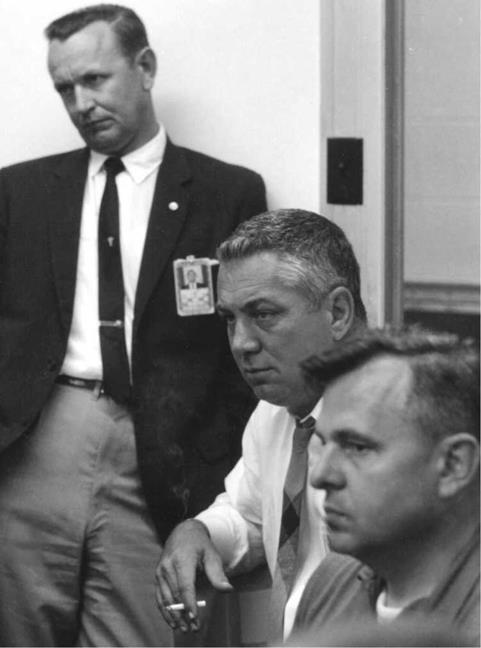
|
|
Mercury Control Center at the Cape prepares for the MR-3 launch. (Photo: NASA) |
“We had been working with a device to collect urine during the flight that worked pretty well in zero-gravity but really didn’t work very well when you were lying on your back with your feet up in the air, like you were on the Redstone. And I thought my bladder was getting a little full and, if I had some time, I’d like to relieve myself. So I said…
“Gordo?”
“Go, Alan?”
“Man, I got to pee!”
“You what?”
“You heard me. I’ve got to pee. I’ve been in here forever. The gantry is still right here, so why don’t you guys let me out of here for a quick stretch?”
“Hold on,” came Cooper’s response. He consulted with Wernher von Braun and a few minutes later came back. “No way, Alan. Wernher says we don’t have the time to reassemble the White Room. He says you’re in there to stay.”
“Gordo, I could be in here a couple more hours, and by that time my bladder’s gonna burst!”
“Wernher says no.”
“Well, shit, Gordo, we’ve got to do something. Dammit, tell ’em I’m going to let it go in my suit!”
“No! No, good God, you can’t do that,” Cooper called back. “The medics say you’ll short-circuit all their medical leads.”
“Tell ’em to turn the power off!”
The solution was that simple. “Gordo had a chuckle in his voice when he told me, ‘Okay, Alan. Power’s off. Go to it.’ It was as if they’d designed the suit for such an emergency. In that semi-supine position the liquid pooled in the small of my back and my heavy undergarment soaked it up. With 100 percent oxygen flowing through the suit, I was soon dry. The countdown resumed. The gantry was gone.” [27]
Knowing that his family was watching a live television transmission from the Cape, Shepard called Cooper in the blockhouse once again and requested that he get Shorty Powers to ring Louise and let her know he was fine despite the delay, which had extended to 1 hour 26 minutes and pushed back the projected time of liftoff.
|
Gordon Cooper communicating with Alan Shepard with Wernher von Braun looking on. (Photo: NASA) |
|
An aerial view of the Pad 5 blockhouse at Cape Canaveral. (Photo: NASA) |
Then, with 2 minutes 40 seconds remaining on the clock, technicians noticed that the fuel pressure in the Redstone was running a little high, and Shepard was warned there might be another short delay. Having heard enough of what he felt was a severe case of over-caution, there was a brittle snap to his voice when he responded. “Shit! I’ve been here more than three hours. I’m a hell of a lot cooler than you guys are. Why don’t you just fix your little problem and light this candle!” [28]
Without being unkind towards Alan Shepard, and the way in which this incident is portrayed in the movie The Right Stuff, his words didn’t galvanize the firing team into action – in fact, the blockhouse technician most involved, Andy Pickett, was not even in the capsule-blockhouse voice loop. He had noticed and reported an irregular reading on the propulsion regulator, which indicated a slight pressure increase. He then flicked a switch a couple of times to open and close a vent valve. This rectified the problem, and the pressure returned to normal within one minute of the anomaly being noticed. The countdown was resumed.
On hearing that the technical glitch had been fixed, Shepard gave a sigh of relief, then called Slayton, who had taken over direct communications from Gordon Cooper in the blockhouse.
“Are we ready, Deke?” he asked, and got the answer he wanted.
“Ready, Al.”
|
The articulated “cherry picker” in place, ready to conduct an astronaut evacuation in the event of a launch mishap. (Photo: NASA) |
The spindly “cherry picker” swung to its standby position by the Redstone, ready to move in and retrieve the astronaut in the event of a looming disaster.
The rocket was ready, the spacecraft was ready, the range was ready, and Shepard was most definitely ready; it was time to light the candle.











